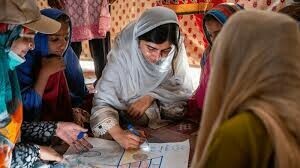ISLAMABAD, March 8: The threat of winter creating a second humanitarian disaster after the Oct 8 earthquake that killed more than 80,000 people in northern areas had been averted, a UN official declared Wednesday.
In a press conference marking five months since the quake, UN Deputy Humanitarian Aid Coordinator Jamie McGoldrick said the worst of winter had passed without a second wave of deaths, a large population exodus from the mountains, severe malnutrition or outbreaks of epidemics.
“We think the winter phase is over; the winter race has been won,” Mr McGoldrick told reporters.
The UN would soon announce a one-year plan starting in April for recovery and reconstruction in the disaster area to follow the initial emergency response phase, he said.
“We have to use this opportunity to support and to encourage the support of people (to get) back to their places of origin so we can help rebuild their lives,” the UN official said.
The quake killed about 87,000, mostly in AJK , and left over three million people homeless.
In the aftermath of the disaster, the UN had warned of a “second wave” of deaths unless international donors sustained a massive relief effort through the frigid winter.
Despite sub-zero temperatures in the mountains and some heavy snow storms, the winter was milder than usual, while aid agencies have ferried food and supplies to isolated communities across the stricken region.
Mr McGoldrick said the unusually short winter and international assistance, particularly helicopters, helped avert a potential humanitarian crisis. The UN has airlifted up to 400 ton of supplies a day so most survivors did not have to abandon their homes.
“People didn’t come down from the mountains and overwhelm the town areas, which were quite congested anyway,” he said.
“There were no glaring issues of people not receiving assistance— food, shelter and water sanitation— and as a result of that, there were no outbreaks of any illnesses that would usually be associated with camp life in these conditions,” he added.
Mr McGoldrick said health indicators and nutritional assessments were the same now in the disaster area as they were before Oct 8.
With the spring thaw, the government plans to close by the end of March the relief camps that have housed more than 200,000 people through winter.
About 2 million other quake survivors have been staying in tents elsewhere, and about 400,000 have lived in tin shacks in the mountains.
Shahnaz Wazir Ali, executive director of the Non-Government Aid Organisation Pakistan Centre for Philanthropy, said many people had already returned from camps to their blocks of land where they were living in tents.—AP













































Dear visitor, the comments section is undergoing an overhaul and will return soon.